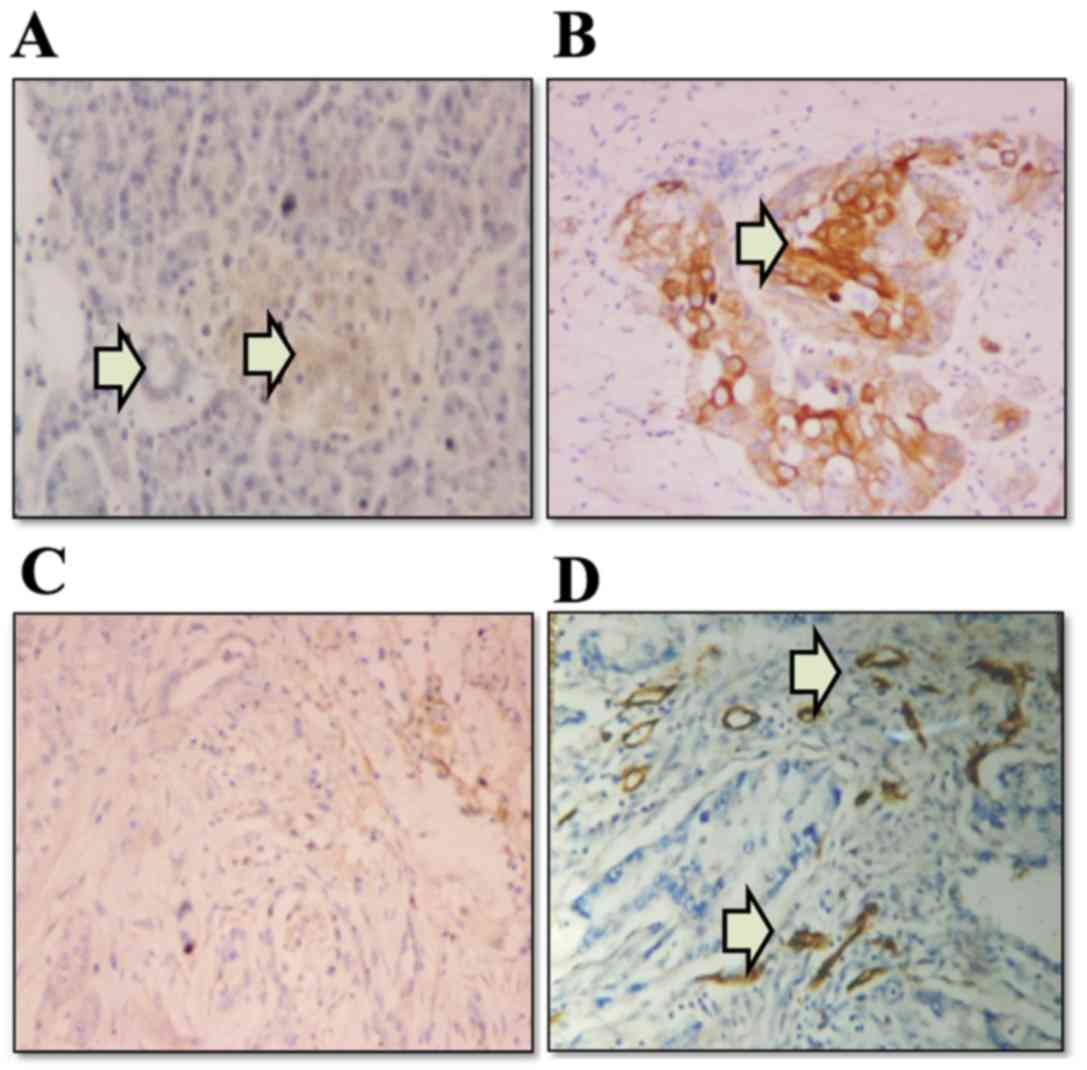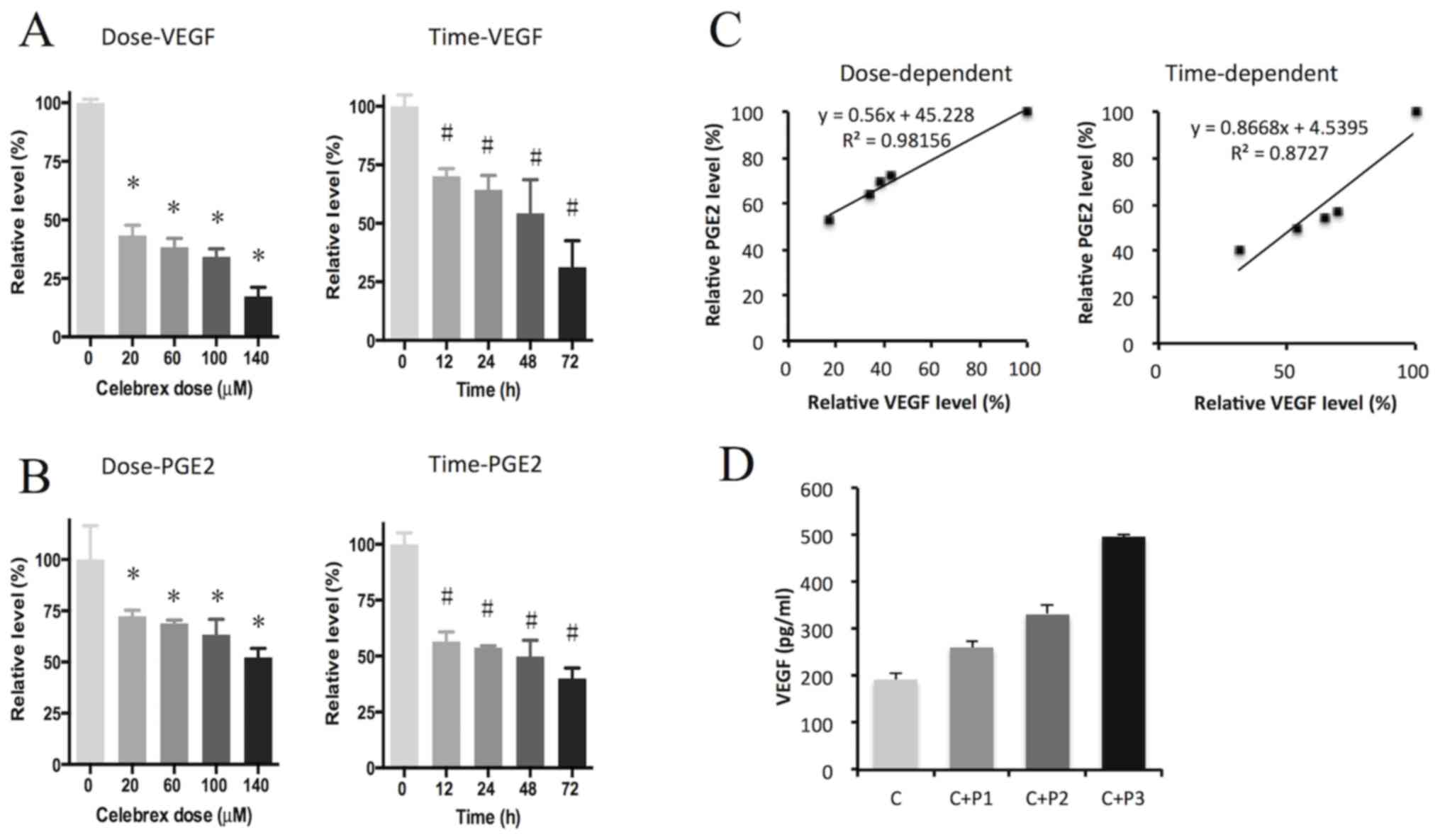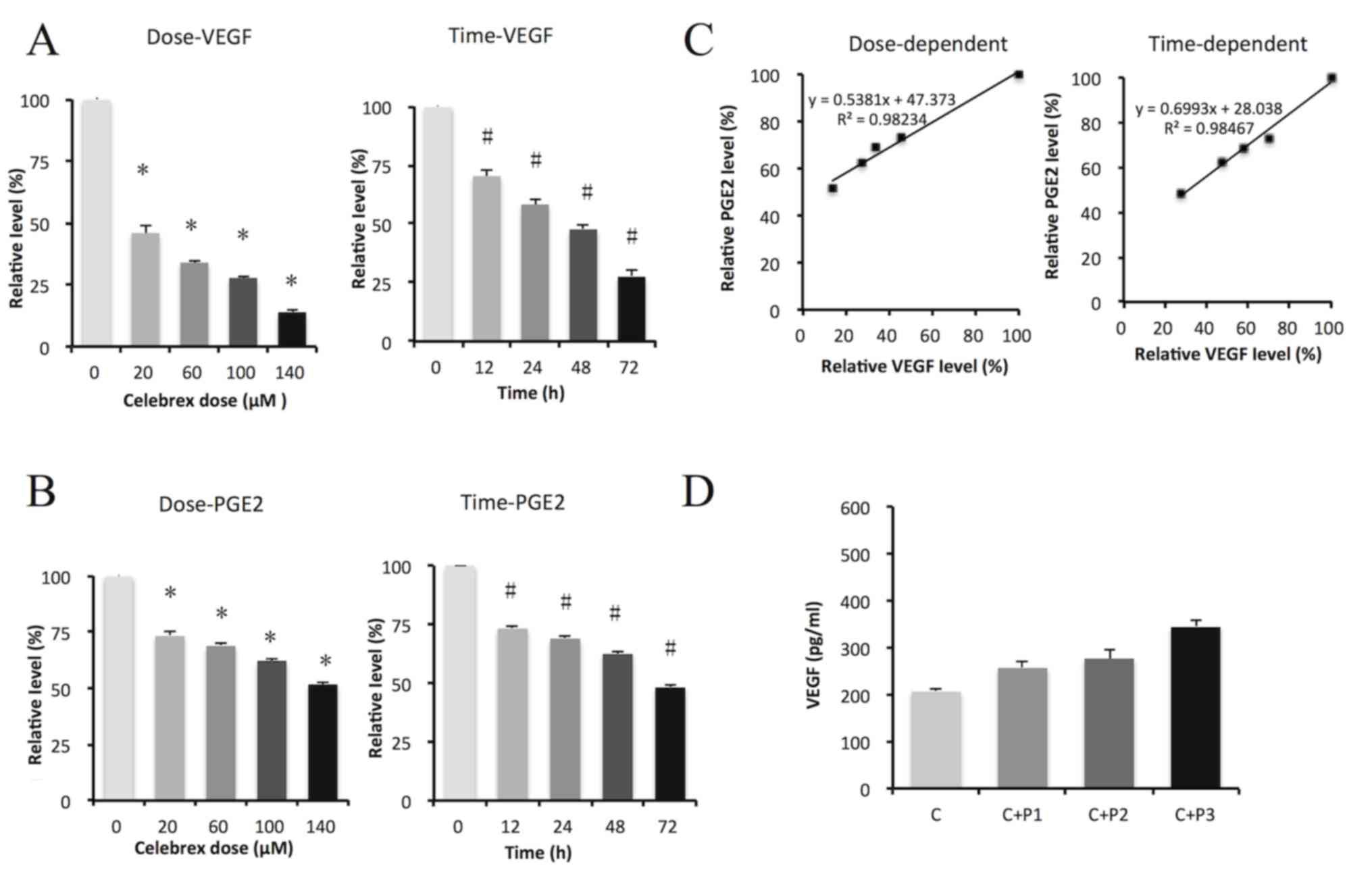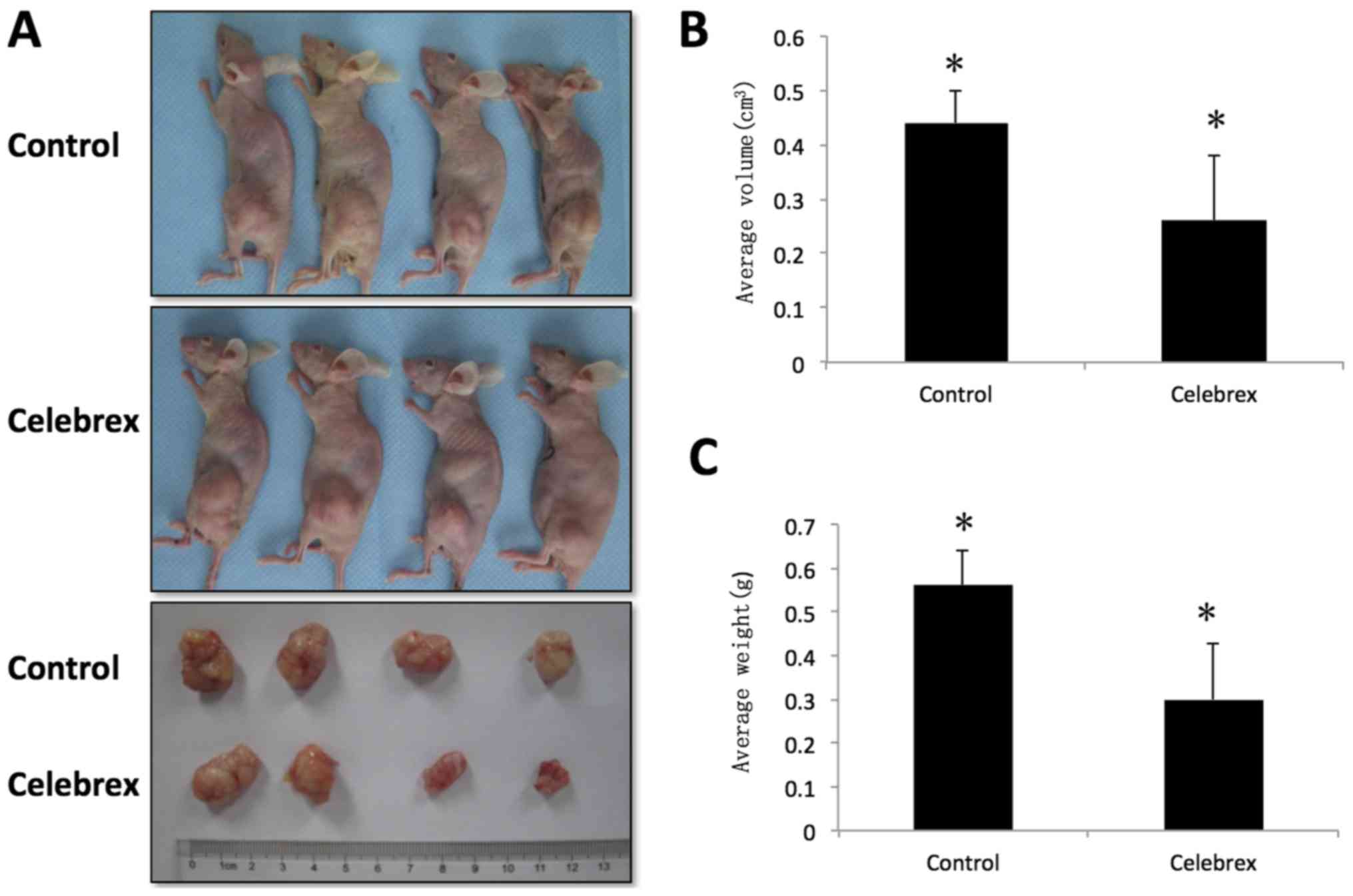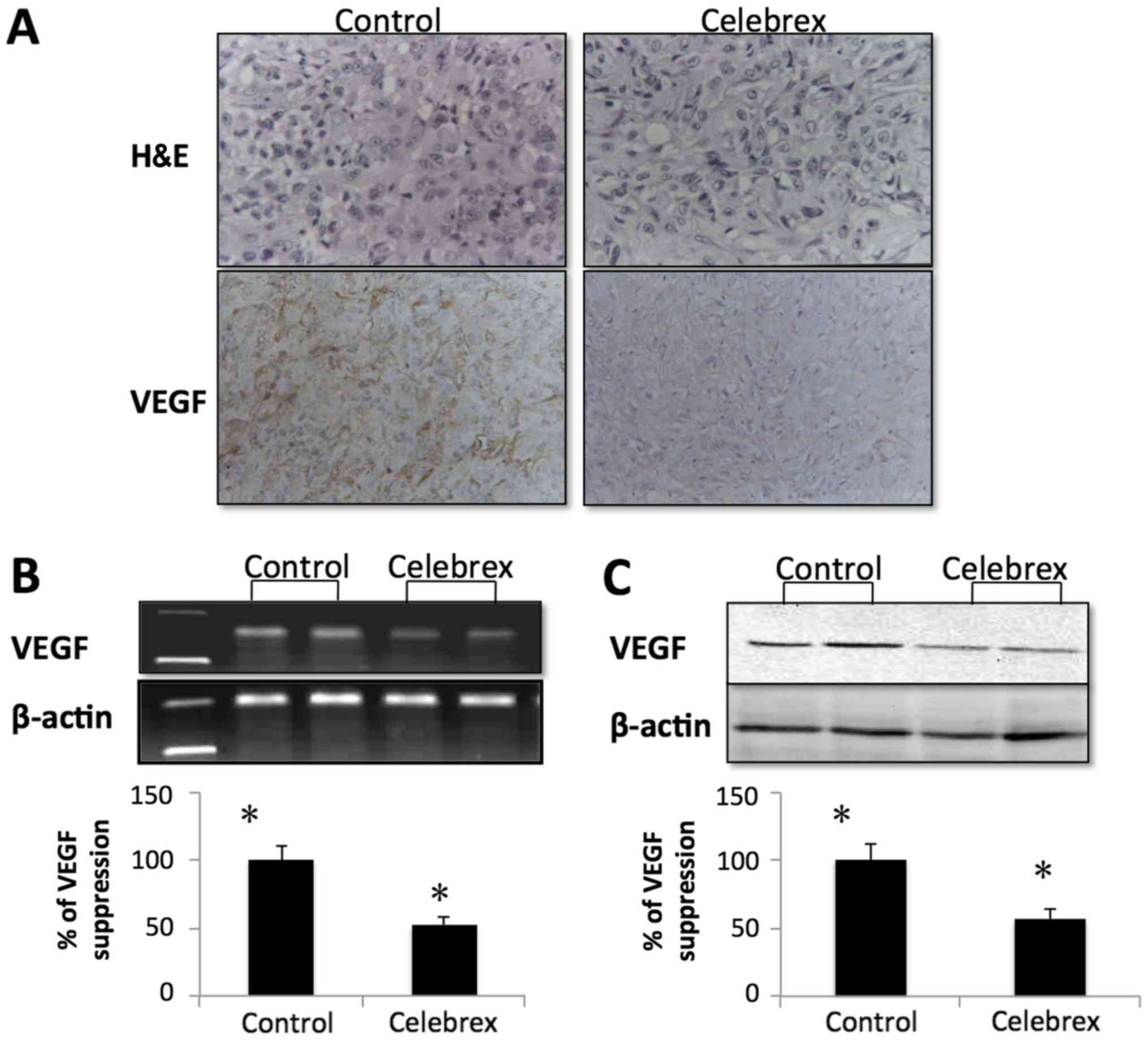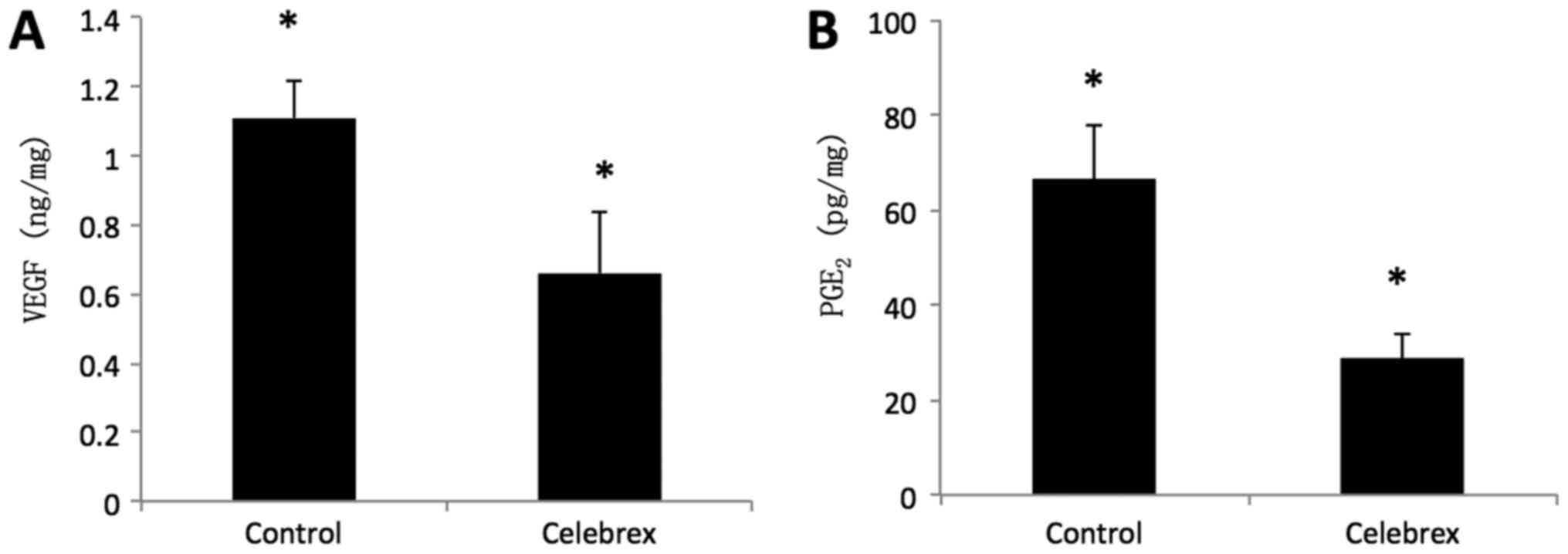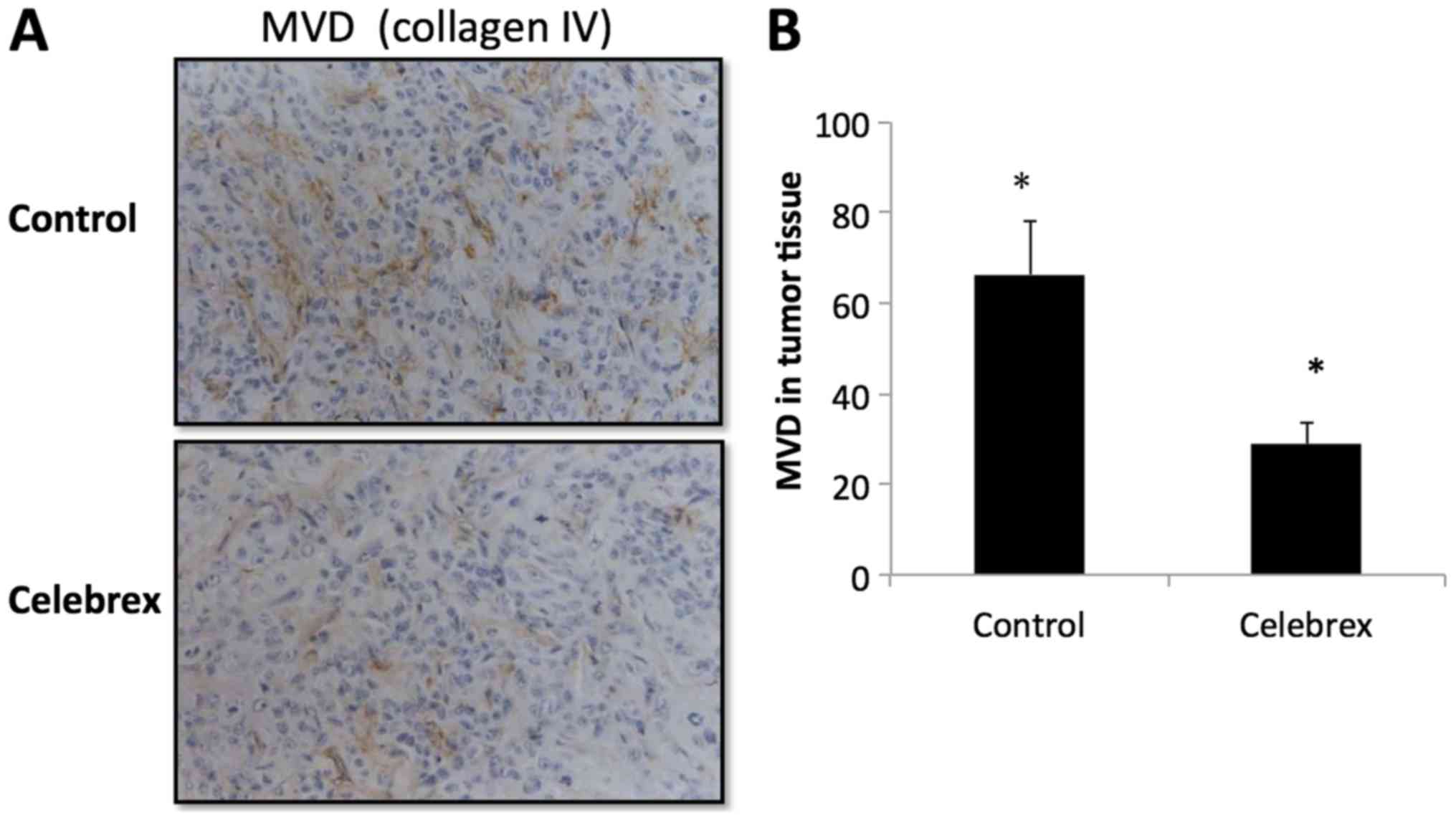Cyclooxygenase‑2 induces angiogenesis in pancreatic cancer mediated by prostaglandin E2
- Authors:
- Published online on: May 22, 2018 https://doi.org/10.3892/ol.2018.8786
- Pages: 940-948
-
Copyright: © Xie et al. This is an open access article distributed under the terms of Creative Commons Attribution License.
Abstract
Introduction
Pancreatic cancer is a deadly disease and is the third leading cause of cancer-associated mortality in the United States of America (1). By 2030, it will be second only to lung cancer in the USA (1). Pancreatic cancer is often diagnosed at advanced stages, with local invasion and remote metastasis, making surgical resection difficult and less effective (2,3). Therefore, developing chemopreventive measures for pancreatic cancer is an important avenue of future study.
Cyclooxygenase-2 (COX-2) has been demonstrated to be an important promoter of tumor growth in various cancer types, and has been considered as a target for therapy (4,5). Previous studies revealed that COX-2 was overexpressed in various types of gastrointestinal and pancreatic cancers and that its expression level is associated with a poor prognosis (6–8). Therefore, inhibition of COX-2 may have a potential therapeutic effect on pancreatic cancer treatment.
Previous data have demonstrated that COX-2 serves an important role in the development of tumors, and the underlying mechanisms include the regulation of proliferation, apoptosis, angiogenesis and metastasis (9,10). It has been indicated that the supply of nutrition from new blood vessels assists in increasing the tumor diameter, without which it is difficult for the tumor to exceed 0.2 cm; a tumor diameter >1.0 cm is an important indicator for increased risk of tumor metastasis. Therefore, angiogenesis serves an important role in tumor formation, invasion and metastasis (11). Tsujii et al (12) indicated that COX-2 promoted the angiogenesis of colon cancer by upregulating angiogenic factors including vascular endothelial growth factor (VEGF), basic fibroblast growth factor (bFGF), bFGF binding protein, transforming growth factor-β, platelet-derived growth factor B, endothelin-1 and nitric oxide synthase in vitro. In another study, NS398, a selective COX-2 inhibitor, significantly inhibited angiogenesis in prostate cancer in vivo (13). These studies provide evidence that COX-2 participates in the regulation of angiogenesis, which is important for tumor formation. Prostaglandin E2 (PGE2), an important intermediate of COX-2-catalyzed arachidonic acid, is overexpressed in a wide variety of tumors and is associated with tumor development (14). A study by Eibl et al (15) demonstrated that in a subset of pancreatic cancer cell lines, COX-2 increased PGE2 which subsequently increased VEGF secretion, suggesting an important role in the angiogenesis of pancreatic cancer.
Although COX-2 has been studied in various types of cancer (4–8), its association with pancreatic cancer has not been fully elucidated. Therefore, the present study investigated the effects of COX-2 on the expression of VEGF and PGE2 in pancreatic cancer in vitro and in vivo. These data will further assist in revealing the regulatory mechanisms of COX-2 in pancreatic cancer angiogenesis.
Materials and methods
Patient samples
A total of 24 paraffin-embedded pancreatic adenocarcinoma tissues (from 10 males and 14 females; mean age, 55.2 years; range, 42–76 years) collected between January 2010 and January 2011 and obtained from The Second Affiliated Hospital of Zhejiang University (Hangzhou, China), were analyzed by immunohistochemistry. The study protocol was approved by the Ethics Committees of The Second Affiliated Hospital of Zhejiang University School of Medicine. Informed consent was obtained from all patients, agreeing to surgical excision and participation in the present study.
Cell culture, reagents and antibodies
The human pancreatic carcinoma PC-3 cell line was a kind gift from Dr Liu Tonghua (Xiehe Hospital, Beijing, China) and the AsPC-1 cell line was purchased from Shanghai cell bank (Shanghai, China). The cell lines were cultured in RPMI-1640 medium (Gibco; Thermo Fisher Scientific, Inc., Waltham, MA, USA) containing 10% fetal bovine serum (GE Healthcare Life Sciences, Logan, UT, USA) without antibiotics in an incubator with 5% CO2 at 37°C. Celebrex was purchased from Sigma-Aldrich; Merck KGaA (Darmstadt, Germany) and was dissolved in 100% dimethyl sulfoxide (DMSO), then diluted with RPMI-1640 for subsequent experiments. The final concentration of DMSO for all treatments, including controls, was maintained at 0.1%. All drug solutions were prepared on the day the experiments were performed. COX-2 rabbit polyclonal antibody (cat. no. 160107) was purchased from Cayman Chemical Company (Ann Arbor, MI, USA). Primary antibodies against VEGF (cat. no. sc-7269) and collagen IV (cat. no. sc-59814) were purchased from Santa Cruz Biotechnology, Inc. (Dallas, TX, USA). All secondary antibodies (cat. no. BA1080; HRP-conjugated protein A and cat. no. BA1050, goat anti-mouse secondary antibody) were obtained from Wuhan Boster Biological Technology, Ltd. (Wuhan, China).
Immunohistochemistry for COX-2, VEGF and collagen IV by light microscopy
Immunohistochemical procedures were performed for the identification of COX-2 and VEGF expression, and microvascular density (MVD) in the paraffin-embedded tissue samples. Briefly, following dewaxing with xylene and rehydrated in a series of decreasing alcohol concentrations (100, 90, 70 and 50% ethanol; 5 min each), 5-µm thick sections were soaked at room temperature in 1% hydrogen peroxide liquid for 15 min, and then blocked at room temperature with 2% bovine serum albumin (BSA; Sigma-Aldrich; Merck KGaA) in phosphate-buffered saline (PBS) for 30 min. The sections were incubated with the primary antibodies, as previously mentioned (1:100 dilution for COX-2; 1:200 dilution for VEGF and collagen IV, respectively) in a humidified chamber for 15–18 h at 4°C and incubated with the corresponding horseradish peroxidase (HRP)-conjugated secondary antibodies, as previously mentioned (1:200 dilution) for 1 h at room temperature. This was followed by incubation with 3,3′-diaminobenzidine solution at room temperature for 2 min (cat. no. D3939; Sigma-Aldrich; Merck KGaA). The intensity of COX-2 and VEGF positivity was classified into 4 grades semi-quantitatively: 0, no staining of cancer cells; 1, weak staining with a light brown color; 2, moderate staining with brown color; and 3, strong staining with dark brown. Collagen IV staining was performed, and the areas with the highest MVD were selected at magnification, ×100. The number of capillaries was counted in 4 randomly selected fields at magnification, ×200 and the mean value was calculated. The immunohistochemical intensity and pathological characteristics of all tumor specimens used in the present study were examined by an independent pathologist.
Reverse transcription polymerase chain reaction (RT-PCR) analysis
Total RNA was isolated from cultured cells by TRIzol® (Life Technologies; Thermo Fisher Scientific, Inc.) and was reverse transcribed by M-MLV Reverse Transcriptase kit (cat no. A1250; Promega Corporation, Madison, WI, USA) using oligo (dT) primers at 42°C for 60 min. cDNA products were subjected to 35 cycles of PCR amplification as follows: 94°C for 5 min followed by 30 cycles of 94°C for 30 sec, 60°C for 30 sec and 72°C for 30 min followed by a final extension step of 72°C for 5 min. The primers used were as follows: COX-2 forward, 5′-TGAAACCCACTCCAAACACAG-3′ and reverse, 5′-TCACAGGCACAGGAGGAAG-3′ (232 bp); and VEGF forward, 5′-ATGAACTTTCTGCTGTCTTG-3′ and reverse, 5′-TGCATGGTGATGTTGGAC-3′ (382 bp). The primers used for β-actin forward, 5′-GGGACCTGACTGACTACCTC-3′ and reverse, 5′-TCATACTCCTGCTTGCTGAT-3′ were purchased from Sangon Biotech Co., Ltd. (Shanghai, China).
VEGF ELISA
The human pancreatic cancer PC-3 cells were plated in a 96-well plates (5×103 cells/well) and cultured for 24 h in RPMI-1640 supplemented with 10% FBS (Gibco; Thermo Fisher Scientific, Inc.). In the dose-effect group, the cells were treated with 0, 20, 60, 100 and 140 µM Celebrex for 3 days. In the time-effect group, the cells were treated with 100 µM Celebrex for 0, 12, 24, 48 and 72 h. In the PGE2 intervention experiment, PC-3 cells were treated with 100 µM Celebrex and different concentrations of PGE2 simultaneously as indicated in the following four groups at 37°C for 3 days: Celebrex (C), Celebrex + 0.1 µM PGE2 (C+P1), Celebrex + 1 µM PGE2 (C+P2) and Celebrex + 10 µM PGE2 (C+P3). The supernatant was collected by centrifugation at 2,500 × g for 10 min at 4°C. VEGF proteins were assayed using human VEGF ELISA kits (cat no. EK0539; Boster Biological Technology, Pleasanton, CA, USA).
Radioimmunoassay (RIA) for PGE2
According to the aforementioned description, the cells were divided into two groups: The dose-effect and the time-effect groups. After 3 days, the supernatant was collected by centrifugation at 2,500 × g for 10 min at 4°C and the levels of PGE2 were measured by RIA using the Prostaglandin E2 125I RIA kit (Amersham; GE Healthcare, Chicago, IL, USA). Following the establishment of the xenograft mouse model, described subsequently, nude mouse tumor tissues (100 mg) were obtained and centrifuged at 7,500 × g for 10 min at 4°C with 1 ml normal saline to collect the homogenate. The levels of PGE2 in the supernatant were then measured using RIA.
Western blot analysis
Tumor tissues were lysed in radioimmunoprecipitation assay lysis buffer [150 mM NaCl, 20 Mm Tris-HCl (pH 7.4), 5 mM EDTA, 1% Na-deoxycholate, 1% NP-40, 0.1% SDS, 1 mM PMSF, 20 mg/ml Aprotini, 20 mg/ml leupeptin and 3 mg/ml Pepstatin A] and the protein concentration was determined using a BCA kit (Nanjing KeyGen Biotech Co., Ltd., Nanjing, China). 20 µg of total proteins per lane were separated using 10% SDS-PAGE and transferred onto a nitrocellulose membrane. The membranes were blocked at 4°C for 1 h in 5% BSA in TBST buffer containing 0.1% Tween-20, and then were incubated with the indicated primary antibodies (previously stated) overnight at 4°C. Subsequently, HRP-conjugated secondary antibodies as aforementioned were incubated with the membranes at room temperature for 1 h at a 1:1,000 dilution, and detected using an enhanced chemiluminescence detection system (Amersham; GE Healthcare). Quantity One software (version 4.62; Bio-Rad Laboratories, Inc., Hercules, CA, USA) was used to quantify the western blots.
Human pancreatic cancer nude mouse model
A total of 20 specific pathogen-free, 6-week-old, female, BALB/C-nu/nu mice were purchased from the Cancer Research Center of Shanghai (Shanghai, China). The mice were raised under controlled 12 h light-dark cycles, with constant temperature (22–24°C) and humidity (55–60%) in a pathogen-free animal research center in the Zhejiang Chinese Medical University (Hangzhou China), and had continuous free access to sterilized food (γ-ray-irradiated food) and autoclaved water. Following 1 week of acclimation, experiments were initiated. To form the xenograft tumors, human pancreatic cancer PC-3 cells were cultured and trypsinized, and then washed and re-suspended in PBS. Next, 1×107 cells were inoculated subcutaneously into the left lower limbs of the mice. A total of 2 weeks later, when the tumor nodules were visible (~5 mm3), the mice were separated randomly into two groups: The control and the Celebrex treatment groups. Mice in the Celebrex treatment group were fed with food containing 1,500 ppm Celebrex, and those in the control group were fed with normal food alone. The sizes of the tumors were measured weekly using calipers. Tumors were harvested 3 months after the drug treatment. The length (L), width (W) and height (H) of the tumors were measured using calipers, and the volumes of the tumors were calculated using the following formula: V=л(L × W × H)/6. The mice were anesthetized prior to cervical dislocation using 45 mg/kg pentobarbital sodium at the culmination of the experiment.
Statistical analysis
Continuous variables were expressed as the mean ± standard error and a non-paired Student's t-test was used for statistical evaluation. Comparisons of means of the VEGF or PGE2 expression rate among groups of different drug concentrations or different treatment times were performed by one-way analysis of variance, followed by Tukey's multiple means comparison test. P<0.05 was considered to indicate a statistically significant difference. In addition, scatter plotting was applied and an R2 value was calculated via Pearson's correlation test to estimate the correlation between VEGF and PGE2 levels. When the ratio was close to 1, the predominant correlation was indicated. Statistical analysis was performed with SPSS v.13.0 (SPSS, Inc., Chicago, IL, USA).
Results
COX-2 and VEGF expression in paraffin-embedded tissue samples
The expression levels of COX-2 and VEGF proteins in the paraffin-embedded tissue samples from 24 patients with pancreatic adenocarcinomas were investigated by immunohistochemistry (Fig. 1). COX-2 immunoreactivity was detected in 21 (87.5%) patients with pancreatic adenocarcinoma (3 negative; 10 weak; and 11 moderate or strong staining). COX-2 immunoreactivity was localized almost exclusively in the neoplastic cells, whereas the stroma of the tumors appeared negative (Fig. 1B). In the normal pancreatic tissues, pancreatic ductal epithelial and acinar cells were negative for COX-2, although the normal islet cells indicated weakly positive staining (Fig. 1A). VEGF immunoreactivity was detected in 14 patients (58.3%) with pancreatic adenocarcinoma (10 negative; 5 weak; and 9 moderate or strong staining). Positive staining of VEGF was characterized by uniform intracytoplasmic, tan, fine granular staining (Fig. 1C).
MVD in paraffin-embedded tissue samples
Angiogenesis in paraffin-embedded human pancreatic cancer tissue samples was also studied by immunostaining for collagen IV (Fig. 1D). In 11 out of 24 cases, moderate or strong staining for COX-2 expression was observed, with a mean MVD of 71.6±24.9. In the other 13 cases with negative or weak COX-2 expression, the average MVD was 38.4±20.9. There was a significant difference between these two groups (P<0.05; Table I).
In the VEGF-negative and weak group, the mean MVD was 40.8±21.8, while in the VEGF-positive group, the mean MVD was 61.8±31.3. Although the mean MVD in the VEGF-positive group was increased compared with that in the VEGF-negative group, no statistical difference between these two groups was observed (P>0.05; Table I).
VEGF and PGE2 expression in human pancreatic cancer PC-3 cell line
In order to investigate the inhibitory effects of Celebrex on the expression of VEGF and PGE2, these two components were detected in the PC-3 cell supernatants by ELISA and RIA, respectively. The results indicated that VEGF and PGE2 were significantly suppressed by Celebrex treatment in a dose- and time-dependent manner (P<0.05; Fig. 2A and B). Scatter plots also showed a prominent correlation between VEGF and PGE2 levels in a dose- and time-dependent manner, with an R2 value close to 1 (Fig. 2C). The effect of exogenous PGE2 on the downregulation of VEGF by Celebrex was also assessed, and the results demonstrated that exogenous PGE2 rescued the suppression of VEGF induced by Celebrex treatment in a dose-dependent manner (Fig. 2D). This experiment was repeated with AsPC-1 cells, and similar results were obtained, as demonstrated in Fig. 3. VEGF and PGE2 were significantly suppressed by Celebrex treatment in a dose- and time-dependent manner (P<0.05; Fig. 3A and B). Scatter plots showed a prominent correlation between VEGF and PGE2 levels in a dose- and time-dependent manner, with an R2 value close to 1 (Fig. 3C). Exogenous PGE2 rescued the suppression of VEGF induced by Celebrex treatment in a dose-dependent manner (Fig. 3D).
VEGF, PGE2 and MVD in PC-3 cell line xenograft nude mice
By the end of the experiment, 9 nude mice in the control group had survived, and 8 nude mice in the Celebrex treatment group had survived; all others (n=3) succumbed to lung infections. The results of the efficacy trials of Celebrex in PC-3 cell xenografts grown in nude mice are presented in Fig. 4A, and the tumor weight and volume at the termination of treatment are indicated in Table II and Fig. 4B and C. No multiple tumors were observed in any individual animal. The volume of the tumors in the group treated with Celebrex was significantly decreased compared with that in the control group treated with normal food. A 50% suppression of the tumor volume was identified in the experimental group, which was statistically different compared with that of the control group (P<0.01).
VEGF expression in tumor tissues were examined by immunohistochemistry, RT-PCR and western blot analysis. Compared with the control group, as demonstrated in Fig. 5A by immunohistochemistry, the expression of VEGF was suppressed. The expression of VEGF mRNA was also markedly downregulated in the Celebrex treatment group (Fig. 5B). Concurrently, VEGF protein expression in the tumor tissues was suppressed in the Celebrex treatment group compared with the control group by western blot analysis (Fig. 5C).
The concentration of VEGF and PGE2 in the tumor tissues of the nude mice was examined by ELISA and RIA, respectively. The results revealed that the concentration of VEGF in the Celebrex group (0.65±0.18 ng/mg) was significantly decreased compared with that in the control group (1.11±0.12 ng/mg) (P<0.01; Fig. 6A). Similarly, the concentration of PGE2 (28.72±4.91 pg/mg) in the Celebrex treatment group was significantly decreased compared with that in the control group (66.36±11.60 pg/mg) (P<0.01; Fig. 6B).
The MVD in the tumor tissues was indicated by collagen IV staining (Fig. 7). The data revealed that the mean MVD was 63.89±13.67 in the control group and 32.25±12.99 in the Celebrex treatment group, indicating that Celebrex significantly reduced the MVD of tumor tissue in the nude mice (P<0.01).
Discussion
The tumor microenvironment is complicated and maintains the stable survival of pancreatic cancer cells despite various perturbations, such as hypoxia (16,17). When the environment is not optimal, pancreatic cancer cells adopt adaptive changes, such as stimulation of tumor angiogenesis. Tumors require a blood supply for nutrition, growth and distant metastasis, and angiogenesis serves a critical role in these processes and is considered one of the major hallmarks of cancer (18,19). Previous studies have indicated that TNP-470, an angiogenesis inhibitor, may significantly inhibit liver metastasis in pancreatic cancer in mice, alone or in combination with cisplatin (20). It has also been suggested that the inhibition of angiogenesis exhibits certain interventional effects on the growth and metastasis of pancreatic cancer (21,22).
The incidence of cancer of the digestive system organs has been demonstrated to be decreased by the use of COX inhibitors, including aspirin, compared with that in untreated control subjects (4). Although non-selective and selective COX-2 inhibitors have been identified to inhibit the growth of several types of cancer cells, accumulating evidence indicates that COX-2 serves a more important role in carcinogenesis compared with COX-1 (5). It has been considered that this mechanism was associated with cell apoptosis induced by non-steroidal anti-inflammatories (9,10). Tsujii et al (12) co-cultured colon cancer Ca-co-2 cells, which overexpressed COX-2, with endothelial cells. It was identified that the colon cancer cells secreted a high concentration of angiogenic factors, including VEGF, basic fibroblast growth factor, transforming growth factor-β1 and platelet-derived growth factor, which stimulated the formation of endothelial tubes, while COX-2 inhibitors significantly inhibited the expression of angiogenesis factors and the formation of endothelial tubes. These findings reveal that COX-2 promotes the growth of colon cancer by promoting tumor angiogenesis.
In the present study, the expression of COX-2 and VEGF, and MVD in human pancreatic cancer tissues was first analyzed. It was identified that COX-2 was commonly expressed in human pancreatic cancer tissues, with staining in the cancer cells but not in the surrounding stroma cells. This is consistent with a previous study indicating that COX-2 was identified in the cultured pancreatic stellate cells, but not in the pancreatic cancer tissue stroma (23). It was also demonstrated that mean MVD was significantly increased in the strongly positive COX-2 expression cases compared with that in the weak expression and negative cases (P<0.01). Additionally, it was revealed that Celebrex, a selective COX-2 inhibitor, reduced the mean MVD in PC-3 xenograft tissues in the nude mice in vivo, confirming the important role of COX-2 in angiogenesis.
Concurrently, the present study revealed positive VEGF expression in 58.3% of human pancreatic cancer tissues, and the mean MVD in the VEGF-positive cases was increased compared with that in the VEGF-negative cases, but no statistical differences were observed. These results were inconsistent with a previous study (24), potentially due to the small number of samples in the present study.
A previous study demonstrated that the selective COX-2 inhibitor reduced the secretion of VEGF in prostate cancer PG-3ML and LNCaP cell lines, in a dose- and time-dependent manner, under hypoxic conditions induced by CoCl2 (25). An additional study indicated that the expression of VEGF secreted by fibroblast cells and macrophages was in accordance with the dosage of the selective COX-2 inhibitors (9). In the present study, it was identified that Celebrex inhibited the secretion of VEGF in PC-3 cells. With the increased drug concentrations and time intervals, the inhibitory effect became more marked in a dose- and time-dependent manner, additionally confirming that COX-2 participated in the angiogenesis of pancreatic cancer by regulating the expression of VEGF.
In our previous study, the effect of Celebrex on cell viability was confirmed and it was demonstrated that Celebrex inhibited cell survival through the induction of apoptosis (26). The study also identified that although the VEGF secretion was decreased in the supernatant of the PC-3 cells following Celebrex treatment, the mRNA expression of VEGF did not exhibit the corresponding change. This suggested that the VEGF suppression was due to the apoptosis of the cultured cells. Considering the number of surviving cells, the VEGF secretion rate per cell was also calculated, and it was revealed that VEGF concentration was decreased at the lower concentration of Celebrex treatment (20 µM), but increased marginally at the higher concentrations (60, 100 and 140 µM). Therefore, we hypothesized that Celebrex inhibited VEGF expression through the induction of apoptosis, and that a lower concentration is optimal for the inhibition of angiogenesis (27). Notably, in the in vivo nude mouse xenograft model of the present study, it was identified that Celebrex downregulated VEGF mRNA and protein expression levels. The aforementioned results suggest that the mechanism of COX-2 to promote tumor angiogenesis may not only by regulating VEGF, but also other unknown angiogenic factors in pancreatic cancer.
COX-2 is an important rate-limiting enzyme involved in prostaglandin synthesis in the process of arachidonic acid metabolism (4). Previous studies have indicated that treatment with PGE2 only may stimulate angiogenesis (28,29). The expression of PGE2 in the pancreatic cancer PC-3 cell line was investigated by RIA in the present study, and it was demonstrated that Celebrex significantly reduced the expression of PGE2 in PC-3 cells and transplanted tumor tissues. The effect of exogenous PGE2 on the downregulation of VEGF by Celebrex was also assessed, and the results indicated that exogenous PGE2 may partly reverse the decreased expression of VEGF initiated by Celebrex in PC-3 cells in a dose-dependent manner. The data indicate that PGE2 may be an important mediator between COX-2 and VEGF.
A total of 3 mice had succumbed by the endpoint of the experiment. The mice were dissected, and redness and edema of the lung tissues were observed. As this occurred in the control and Celebrex-treated groups, this event was not considered to be associated with Celebrex treatment. We hypothesized that it may be due to the tumor burden and individual differences between mice.
COX-2 expression was upregulated by mitogen-activated protein kinase and protein kinase C pathways, which are activated by various factors, and subsequently promoted prostaglandin synthesis, including PGE1, PGE2 and 15-deoxy-∆-12,14-prostaglandin J2 (30,31). These prostaglandins interacted with their corresponding receptors and activated various intracellular kinases by the E-prostanoid receptor/cyclic adenosine 5′-phosphate pathway (30). They may directly enter into the nucleus via nuclear receptors including peroxisome proliferator-activated receptor γ, to induce the production of various angiogenic factors, including VEGF (31). The findings of the present study also suggested an important role of PGE2 in regulating the expression of VEGF.
In conclusion, COX-2 expression was markedly upregulated in human pancreatic adenocarcinoma cells and serves an important role in promoting the growth of pancreatic cancer. PGE2 may act as an important mediator between VEGF secretion and COX-2 activation. The results of the present study provide an important theoretical basis for the clinical application of COX-2 inhibitors in the chemoprevention of pancreatic cancer. In future studies, we will aim to elucidate the role of Celebrex in chemoprevention.
Acknowledgements
Not applicable.
Funding
This study was supported by the Zhejiang Provincial Natural Science Foundation of China (grant no. LY14C070003) and the Major Social Development Project of Zhejiang Province Major Science and Technology Projects (grant no. 2014C03041-1).
Availability of data and materials
The datasets used and/or analyzed during the current study are available from the corresponding author on reasonable request.
Authors' contributions
CX performed the Celebrex inhibition assay and was a major contributor in writing the manuscript. XF performed the statistical analysis. XW and JTC were main contributors for experiment design and guidance. SW performed the immunohistochemistry study and pathological analysis. LS and JMC performed the nude mice xenograft experiments. LJ performed the RT-PCR and western blot analysis. All authors read and approved the final manuscript.
Ethics approval and consent to participate
The study protocol was approved by the Ethics Committees of the Second Affiliated Hospital of Zhejiang University School of Medicine. Informed consent was obtained from all patients, agreeing to surgical excision and participation.
Consent for publication
All studies participants provided their consent for the publication of this data.
Competing interests
The authors declare that they have no competing interests.
Glossary
Abbreviations
Abbreviations:
|
COX-2 |
cyclooxygenase 2 |
|
VEGF |
vascular endothelial growth factor |
|
PGE2 |
prostaglandin E2 |
|
MVD |
microvascular density |
References
|
Siegel RL, Miller KD and Jemal A: Cancer statistics, 2017. CA Cancer J Clin. 67:7–30. 2017. View Article : Google Scholar : PubMed/NCBI | |
|
Li J, Wientjes MG and Au JL: Pancreatic cancer: Pathobiology, treatment options, and drug delivery. AAPS J. 12:223–232. 2010. View Article : Google Scholar : PubMed/NCBI | |
|
Li D, Xie K, Wolff R and Abbruzzese JL: Pancreatic cancer. Lancet. 363:1049–1057. 2004. View Article : Google Scholar : PubMed/NCBI | |
|
Ranger GS: Current concepts in colorectal cancer prevention with cyclooxygenase inhibitors. Anticancer Res. 34:6277–6282. 2014.PubMed/NCBI | |
|
Fajardo AM and Piazza GA: Chemoprevention in gastrointestinal physiology and disease. Anti-inflammatory approaches for colorectal cancer chemoprevention. Am J Physiol Gastrointest Liver Physiol. 309:G59–G70. 2015. View Article : Google Scholar : PubMed/NCBI | |
|
Ristimäki A, Sivula A, Lundin J, Lundin M, Salminen T, Haglund C, Joensuu H and Isola J: Prognostic significance of elevated cyclooxygenase-2 expression in breast cancer. Cancer Res. 62:632–635. 2002.PubMed/NCBI | |
|
Kondo M, Yamamoto H, Nagano H, Okami J, Ito Y, Shimizu J, Eguchi H, Miyamoto A, Dono K, Umeshita K, et al: Increased expression of COX-2 in nontumor liver tissue is associated with shorter disease-free survival in patients with hepatocellular carcinoma. Clin Cancer Res. 5:4005–4012. 1999.PubMed/NCBI | |
|
Masunaga R, Kohno H, Dhar DK, Ohno S, Shibakita M, Kinugasa S, Yoshimura H, Tachibana M, Kubota H and Nagasue N: Cyclooxygenase-2 expression correlates with tumor neovascularization and prognosis in human colorectal carcinoma patients. Clin Cancer Res. 6:4064–4068. 2000.PubMed/NCBI | |
|
Xu B, Wang Y, Yang J, Zhang Z, Zhang Y and Du H: Celecoxib induces apoptosis but up-regulates VEGF via endoplasmic reticulum stress in human colorectal cancer in vitro and in vivo. Cancer Chemother Pharmacol. 77:797–806. 2016. View Article : Google Scholar : PubMed/NCBI | |
|
Xiao Y, Teng Y, Zhang R and Luo L: Antitumor effect of the selective COX-2 inhibitor celecoxib on endometrial adenocarcinoma in vitro and in vivo. Oncol Lett. 4:1219–1224. 2012. View Article : Google Scholar : PubMed/NCBI | |
|
van Netten JP, Cann SA and van der Westhuizen NG: Angiogenesis and tumor growth. N Engl J Med. 334:920–921. 1996. View Article : Google Scholar : PubMed/NCBI | |
|
Tsujii M, Kawano S, Tsuji S, Sawaoka H, Hori M and DuBois RN: Cyclooxygenase regulates angiogenesis induced by colon cancer cells. Cell. 93:705–716. 1998. View Article : Google Scholar : PubMed/NCBI | |
|
Liu XH, Kirschenbaum A, Yao S, Lee R, Holland JF and Levine AC: Inhibition of cyclooxygenase-2 suppresses angiogenesis and the growth of prostate cancer in vivo. J Urol. 164:820–825. 2000. View Article : Google Scholar : PubMed/NCBI | |
|
Ma X, Aoki T, Tsuruyama T and Narumiya S: Definition of prostaglandin E2-EP2 signals in the colon tumor microenvironment that amplify inflammation and tumor growth. Cancer Res. 75:2822–2832. 2015. View Article : Google Scholar : PubMed/NCBI | |
|
Eibl G, Bruemmer D, Okada Y, Duffy JP, Law RE, Reber HA and Hines OJ: PGE(2) is generated by specific COX-2 activity and increases VEGF production in COX-2-expressing human pancreatic cancer cells. Biochem Biophys Res Commun. 306:887–897. 2003. View Article : Google Scholar : PubMed/NCBI | |
|
Wilson JS, Pirola RC and Apte MV: Stars and stripes in pancreatic cancer: Role of stellate cells and stroma in cancer progression. Front Physiol. 5:522014. View Article : Google Scholar : PubMed/NCBI | |
|
Coffman LG, Choi YJ, McLean K, Allen BL, di Magliano MP and Buckanovich RJ: Human carcinoma-associated mesenchymal stem cells promote ovarian cancer chemotherapy resistance via a BMP4/HH signaling loop. Oncotarget. 7:6916–6932. 2016. View Article : Google Scholar : PubMed/NCBI | |
|
Yang D, Wang LL, Dong TT, Shen YH, Guo XS, Liu CY, Liu J, Zhang P, Li J and Sun YP: Progranulin promotes colorectal cancer proliferation and angiogenesis through TNFR2/Akt and ERK signaling pathways. Am J Cancer Res. 5:3085–3097. 2015.PubMed/NCBI | |
|
Wang W, Sun QK, He YF, Ma DC, Xie MR, Ji CS and Hu B: Overexpression of periostin is significantly correlated to the tumor angiogenesis and poor prognosis in patients with esophageal squamous cell carcinoma. Int J Clin Exp Pathol. 7:593–601. 2014.PubMed/NCBI | |
|
Kawarada Y, Ishikura H, Kishimoto T, Saito K, Takahashi T, Kato H and Yoshiki T: Inhibitory effects of the antiangiogenic agent TNP-470 on establishment and growth of hematogenous metastasis of human pancreatic carcinoma in SCID beige mice in vivo. Pancreas. 15:251–257. 1997. View Article : Google Scholar : PubMed/NCBI | |
|
Khan MA, Srivastava SK, Bhardwaj A, Singh S, Arora S, Zubair H, Carter JE and Singh AP: Gemcitabine triggers angiogenesis-promoting molecular signals in pancreatic cancer cells: Therapeutic implications. Oncotarget. 6:39140–39150. 2015. View Article : Google Scholar : PubMed/NCBI | |
|
Gore J, Craven KE, Wilson JL, Cote GA, Cheng M, Nguyen HV, Cramer HM, Sherman S and Korc M: TCGA data and patient-derived orthotopic xenografts highlight pancreatic cancer-associated angiogenesis. Oncotarget. 6:7504–7521. 2015. View Article : Google Scholar : PubMed/NCBI | |
|
Pomianowska E, Sandnes D, Grzyb K, Schjølberg AR, Aasrum M, Tveteraas IH, Tjomsland V, Christoffersen T and Gladhaug IP: Inhibitory effects of prostaglandin E2 on collagen synthesis and cell proliferation in human stellate cells from pancreatic head adenocarcinoma. BMC Cancer. 14:4132014. View Article : Google Scholar : PubMed/NCBI | |
|
Georgiadou D, Sergentanis TN, Sakellariou S, Filippakis GM, Zagouri F, Vlachodimitropoulos D, Psaltopoulou T, Lazaris AC, Patsouris E and Zografos GC: VEGF and Id-1 in pancreatic adenocarcinoma: Prognostic significance and impact on angiogenesis. Eur J Surg Oncol. 40:1331–1337. 2014. View Article : Google Scholar : PubMed/NCBI | |
|
Liu XH, Kirschenbaum A, Yao S, Stearns ME, Holland JF, Claffey K and Levine AC: Upregulation of vascular endothelial growth factor by cobalt chloride-simulated hypoxia is mediated by persistent induction of cyclooxygenase-2 in a metastatic human prostate cancer cell line. Clin Exp Metastasis. 17:687–694. 1999. View Article : Google Scholar : PubMed/NCBI | |
|
Xu XF, Xie CG, Wang XP, Liu J, Yu YC, Hu HL and Guo CY: Selective inhibition of cyclooxygenase-2 suppresses the growth of pancreatic cancer cells in vitro and in vivo. Tohoku J Exp Med. 215:149–157. 2008. View Article : Google Scholar : PubMed/NCBI | |
|
Xie C, Wang X, Dong Y, Du Q, Cai J and Qian K: Effects of selective cyclooxygenase-2 inhibitor celebrex on the expression of VEGF in pancreatic carcinoma PC-3 cell line. China Oncol. 13:459–461. 2003. | |
|
Cheng T, Cao W, Wen R, Steinberg RH and LaVail MM: Prostaglandin E2 induces vascular endothelial growth factor and basic fibroblast growth factor mRNA expression in cultured rat Müller cells. Invest Ophthalmol Vis Sci. 39:581–591. 1998.PubMed/NCBI | |
|
Jain S, Chakraborty G, Raja R, Kale S and Kundu GC: Prostaglandin E2 regulates tumor angiogenesis in prostate cancer. Cancer Res. 68:7750–7759. 2008. View Article : Google Scholar : PubMed/NCBI | |
|
Mestre JR, Mackrell PJ, Rivadeneira DE, Stapleton PP, Tanabe T and Daly JM: Redundancy in the signaling pathways and promoter elements regulating cyclooxygenase-2 gene expression in endotoxin-treated macrophage/monocytic cells. J Biol Chem. 276:3977–3982. 2001. View Article : Google Scholar : PubMed/NCBI | |
|
Lo CJ, Cryer HG, Fu M and Lo FR: Regulation of macrophage eicosanoid generation is dependent on nuclear factor kappaB. J Trauma. 45:19–24. 1998. View Article : Google Scholar : PubMed/NCBI |



